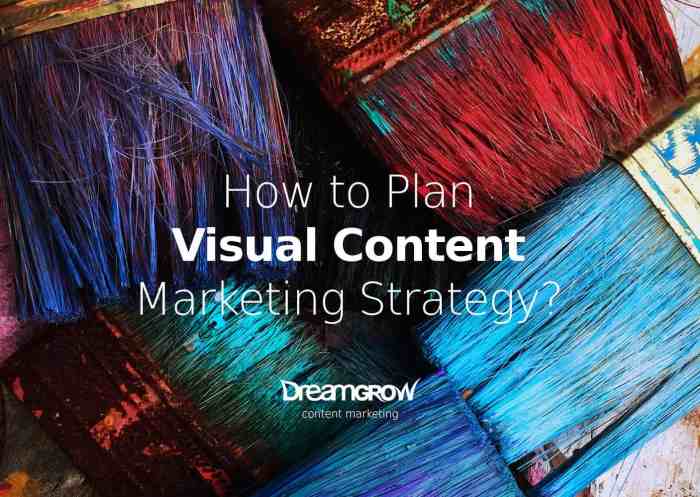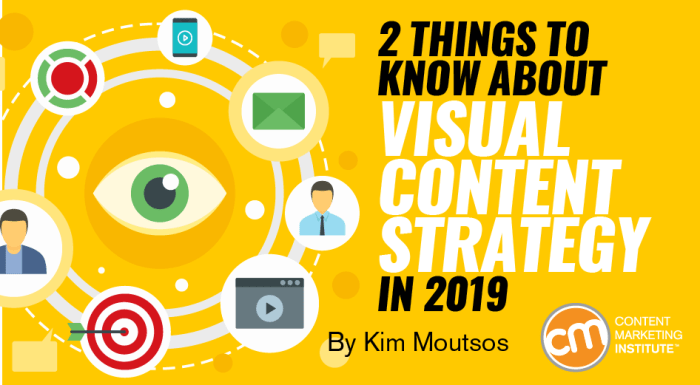Building a Visual Content Strategy is like painting a masterpiece in the digital world, where each stroke of creativity enhances brand identity and captivates audiences. From the importance of visuals to the art of distribution, this journey is a blend of strategy and creativity.
Importance of Visual Content Strategy: Building A Visual Content Strategy
In the world of digital marketing, visual content reigns supreme. It grabs attention, engages audiences, and leaves a lasting impact like no other form of content can. Let’s dive into why having a solid visual content strategy is crucial for any brand looking to make a mark in the digital landscape.
Enhancing Brand Identity
Visual content plays a key role in shaping and reinforcing a brand’s identity. From logos to color schemes to visual elements used in marketing materials, every visual aspect contributes to how a brand is perceived by its audience. Consistency in visual content across all platforms helps in creating a strong brand identity that is easily recognizable and memorable.
- Using unique visual elements such as logos, color schemes, and typography can help differentiate a brand from its competitors.
- Visual content can evoke emotions and connect with audiences on a deeper level, strengthening brand loyalty.
- Consistent visual branding across all platforms helps in building brand recognition and trust among consumers.
Successful Visual Content Strategies
Many companies have leveraged visual content effectively to enhance their brand presence and engage with their target audience. Let’s take a look at a few examples of successful visual content strategies:
- Apple: Known for its sleek and minimalist design approach, Apple’s visual content reflects the brand’s commitment to innovation and modernity. From product packaging to advertising campaigns, Apple’s visuals are instantly recognizable and synonymous with quality.
- Dove: Dove’s “Real Beauty” campaign is a prime example of how visual content can be used to promote a positive message and connect with consumers on a personal level. The campaign features real women of all shapes, sizes, and colors, challenging traditional beauty standards and promoting self-acceptance.
- GoPro: GoPro’s visual content strategy revolves around user-generated content, showcasing the amazing adventures and experiences captured by GoPro users. This approach not only promotes the product but also creates a sense of community and inspires others to share their own stories.
Elements of a Visual Content Strategy

Visual content is a crucial aspect of any successful marketing strategy, and it involves various key components that must be considered to effectively engage the target audience and communicate brand messaging.
Key Components of a Visual Content Strategy
- High-Quality Images: Utilizing captivating and high-resolution images can grab the audience’s attention and enhance brand perception.
- Engaging Videos: Videos are a powerful tool for storytelling and can help in conveying complex messages in a more compelling way.
- Informative Infographics: Infographics are excellent for presenting data and statistics in a visually appealing and easy-to-understand format.
- Consistent Branding: Ensuring that all visual content aligns with the brand’s guidelines and values helps in building brand recognition and trust.
Role of Visual Elements in a Visual Content Strategy, Building a Visual Content Strategy
Visual elements such as images, videos, and infographics play a vital role in capturing the audience’s attention and conveying information effectively. Images can evoke emotions and create a connection with the audience, while videos can provide a more immersive experience. Infographics, on the other hand, are great for simplifying complex information and making it easier to digest.
Aligning Visual Content with Brand Messaging and Target Audience
To ensure that visual content resonates with the target audience and conveys the brand’s message effectively, it is essential to align the visual elements with the brand’s tone, voice, and values. Understanding the target audience’s preferences, interests, and behaviors can help in creating visual content that is relevant and engaging. By maintaining consistency in visual style and messaging, brands can establish a strong brand identity and connect with their audience on a deeper level.
Planning and Research
Research is a crucial step in creating a successful visual content strategy. It helps in understanding the target audience, their preferences, and behavior towards visual content. By conducting thorough research, businesses can tailor their visual content to meet the needs and interests of their audience.
Identifying Target Audience Preferences
To identify target audience preferences for visual content, businesses can utilize tools like Google Analytics to analyze website traffic and social media insights to understand what type of visual content resonates with their audience. Surveys and feedback forms can also be used to gather direct input from the audience.
Planning a Content Calendar
Planning a content calendar for visual content involves understanding current trends in the industry and setting goals for the content strategy. Businesses can use tools like social media scheduling platforms to plan and schedule visual content ahead of time. By aligning the content calendar with trends and goals, businesses can ensure consistency and relevance in their visual content strategy.
Creating Engaging Visual Content

Creating visually appealing graphics and images is crucial for capturing the attention of your audience. Here are some tips to help you design engaging visual content:
Design Tips for Visually Appealing Graphics and Images
- Use high-quality images: Make sure your graphics are clear and crisp to grab attention.
- Keep it simple: Avoid clutter and focus on a clean and organized design.
- Incorporate brand elements: Use colors, fonts, and logos that are consistent with your brand identity.
- Utilize white space: Allow your visuals to breathe by incorporating ample white space.
- Consider mobile optimization: Ensure your graphics are responsive and look great on all devices.
Tools and Resources for Creating High-Quality Visual Content
- Canva: A user-friendly design tool with various templates and customization options.
- Adobe Creative Cloud: Professional suite for graphic design, photo editing, and more.
- Pexels and Unsplash: Platforms for free high-resolution images and videos.
- Google Fonts: Access a wide range of fonts to enhance your visual content.
- Piktochart: Create infographics and visual presentations easily with this tool.
Importance of Consistency in Visual Content Creation
Consistency in visual content across platforms helps establish brand recognition and fosters trust with your audience. By maintaining a cohesive look and feel, you can strengthen your brand identity and create a memorable experience for users. Make sure to use consistent colors, fonts, and design elements to reinforce your brand messaging and values effectively.
Distribution and Promotion
When it comes to promoting visual content on social media channels, it’s essential to tailor your approach to each platform. Consider the preferences and behaviors of users on sites like Instagram, Facebook, Twitter, and Pinterest. Create visually appealing posts that align with the style and tone of each platform to maximize engagement.
Optimizing Visual Content for Search Engines
Optimizing visual content for search engines involves incorporating relevant s in image alt text, file names, and captions. Ensure that your images are high-quality, properly sized, and load quickly to improve . Additionally, consider creating image sitemaps to help search engines index your visual content effectively.
Repurposing Visual Content
Repurposing visual content is a great way to reach a wider audience and extend the lifespan of your creations. Consider turning infographics into video tutorials, transforming blog graphics into social media posts, or creating slideshows from existing images. By repurposing visual content, you can engage different segments of your target audience across various platforms.
